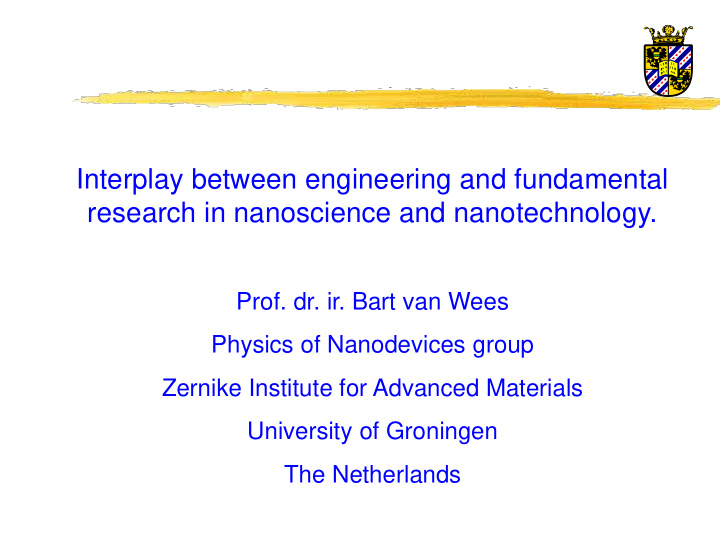



Interplay between engineering and fundamental research in nanoscience and nanotechnology. Prof. dr. ir. Bart van Wees Physics of Nanodevices group Zernike Institute for Advanced Materials University of Groningen The Netherlands
How to recognize scientific disciplines (I)? If it squirms, it's biology. If it stinks, it's chemistry. If you can't understand it, it's mathematics. and… If it doesn't work, it's physics. (attr. to Magnus Pyke)
How to recognize scientific disciplines (II)? If it works, but you don’t understand how, it’s technology ! (unknown author)
Isambard Kingdom Brunel (1806-1859) (Nr 2 on list of 100 Greatest Britons) S.S. Great Eastern Royal Albert Bridge
Brunel’s “Atmospheric Railway”
Quantum point contact ( BJvW1988) Split-gate technique
Quantized conductance of one- dimensional electron channels
Quantum dots and quantum point contacts
2010 Nobel Prize for Physics Prize motivation: "for groundbreaking experiments regarding the two-dimensional material graphene" Andrei Geim Konstantin Novoselov
History of graphene Early development of graphene electronics Walt A. de Heer Georgia Institute of Technology Abstract Graphene has recently emerged as a material likely to complement or eventually succeed silicon in electronics. From 2001 to 2004, groundbreaking research was pursued behind the scenes at Georgia Tech; various directions were explored, including exfoliation techniques and CVD growth, but epitaxial graphene on silicon carbide emerged as the most viable route. This document provides archival information that may otherwise be difficult to obtain, including two proposals on file with the NSF, submitted in 2001 and 2003, and the first graphene patent, filed in 2003. The 2001 document proposes much of the graphene research carried out during this decade, and the 2003 proposal includes the data that was eventually published in J. Phys. Chem. B in Dec. 2004. Note: Some personal information has been removed
Graphene grown on SiC
“Dutch connection”: High Field Magnet Laboratory Nijmegen Type: Bitter Max Field: 33.0 tesla Bore: Ø 32mm at room temp. Power: 17 MW Homogeneity: 1x10-3 in 1 cm DSV
Ig Nobel Prize Given for research achievements: “that first make people laugh, and then make them think." "that cannot or should not be reproduced ." 2000 Physics - Presented to Andre Geim of the University of Nijmegen, the Netherlands, and Michael Berry of Bristol University, England, for using magnets to levitate a frog. Geim later shared the 2010 Nobel Prize in physics for his research on graphene, the first time anyone has been awarded both the Ig Nobel and (real) Nobel Prizes.
Friday afternoon experiment: Levitating frog A live frog levitates inside a 32 mm diameter vertical bore of a Bitter solenoid in a magnetic field of about 16 teslas at the High Field Magnet Laboratory of the Radboud University in Nijmegen the Netherlands But beware of Earnshaw’s theorem!
Earnshaw’s theorem Earnshaw's theorem states that a collection of point charges cannot be maintained in a stable stationary equilibrium configuration solely by the electrostatic interaction of the charges. This was first proven by British mathematician Samuel Earnshaw in 1842. It is usually referenced to magnetic fields, but originally applied to electrostatic fields. It applies to the classical inverse-square law forces (electric and gravitational) and also to the magnetic forces of permanent magnets and paramagnetic materials or any combination, (but not diamagnetic materials).
Levitating other things…
Levitating carbon (graphite) Graphite: • Pencil lead • Moderator in nuclear reactors frog.mpeg * Layered structure * Steelmaking industry * Lubricant * Good electrical conductor
Carbon comes in different dimensions
Scotch tape method (1) Graphite (HOPG) Scotch tape (other brands OK too) Pair of hands (PhD student or other)
Scotch tape method (2) graphite flake
Scotch tape method (3) silicon/siliconoxide substrate
Scotch tape method (4)
Graphene (single and multilayer) under the (optical) microscope
Single graphene layers: A tomic force microscope
Graphene field effect transistor Graphene layer Source Drain Doped Si gate induced charge: Q=C g V g No surface states!
Intermezzo: Solid state bandstructure and energy/momentum E(p) relation electrons electrons kT Fermi energy E energy holes holes momentum p Metal Semiconductor Graphene Kinetic energy: E=p 2 /2m * velocity v=dE/dp m *: effective mass Semiconductors: m * positive for electron states/negative for hole states
Electron transport in graphene 6 metallic metallic graphene resistivity electron 5 hole regime regime 4 Rg(k ) 3 neutrality 2 point 1 -60 -50 -40 -30 -20 -10 0 10 20 Vg(V) gate voltage (carrier density) But similar behaviour for multilayer graphene/graphite!
Anomalous Quantum Hall effect Conventional semiconductor Single layer graphene
Combination of “low tech”and “high tech” Zernike Nanolab Groningen Electron beam lithography
Two-terminal spin valve PARALLEL ANTI-PARALLEL FM1 FM2 FM1 FM2 R large R small R -B c2 -B c1 B c2 B B c 1
Ferromagnetic contacts to graphene flakes Electron beam lithography
Van der Waals materials and devices
Towards new spintronics applications Spintronics Work Package
Engineering your DIY graphene transistor !! You need: Household foil Graphite Cotton wool Multimeter 1) Make the gate first: Cover one side with graphite (rub out wel) 2) Cover other side with graphite (rub out ever better) 3) Measure resistance (it must be 10 k or more) 4) Apply a DC voltage between back and front of the foil (caution!) 5) Voila! Your home made graphene transistor is ready! Congratulations!
Recommend
More recommend